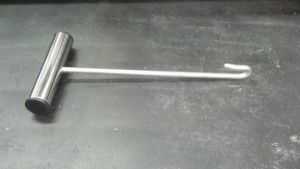 One of the best tools you can have on the boat is a de-hooking device — for a number of reasons.
One of the best tools you can have on the boat is a de-hooking device — for a number of reasons.
1.) Minimizes the injuries from gill rakes and teeth, and the more complicated injuries resulting from bacterial infections due to a simple fin pricks or knicks in the finger/hand, or elsewhere.
A simple T-handle de-hooker can be a total game changer, especially if you do any bottom fishing. All the snappers have the ability to turn on a dime when in or out of the water, and more specifically when they are on the end of your line, in the boat. Of all the fish, the snappers are best candidate for a de-hooker of all for this very reason. They are so quick and powerful they have the ability to flip 180 degrees instantly, thus increasing the chances of an injury.
2.) Reduces the stress of fish to be released.
With off limits fish such as the (supposedly) endangered red snapper, sea bass and gag grouper, the most beneficial method of getting the fish back in the water is to check to see if it needs to be vented. If so, lay the fish on the deck vent properly and pick the fish up by the line/hook and de-hook over board. Do not de-hook the fish inside the boat, let it hit the deck, and then try to get a grip on it with your hands to put over board. Also, do not handle fish to be released with a towel. This will wipe the slime off of them, making them more vulnerable to bacterial problems.
The bigger the snapper (or grouper) the larger the fins and gill rakes. One of the most dangerous things you can do with a fish is to try to wrestle the hook out of a fishes’ mouth with a pair of pliers. The best (safest) method for hook removal is definitely with a de-hooker. This is true with large, or small trolled fish like mackerel, wahoo and dolphin. The mackerel and wahoo have the teeth that demand safety. Regardless of the size, mackerel and wahoo have the hardware that creates the need for stitches, if not handled properly. There are long handled de-hookers made specifically for billfish as well. This will allow you to stay out of the way of a bill that can do some damage to hands and arms
3.) Gives you a more positive control over the fish, if handled correctly.
- For fish going into the cooler:
- Make a wrap or two of the leader material around your hand;
- Open the cooler lid;
- Run the hook section of the de-hooker down the leader until it bites the bend of the hook;
- Pull the de-hooker and the leader in opposite directions, until in comes tight;
- Make a sharp twist on the de-hooker and let the fish fall into the cooler
- Close the cooler lid.
To see the video of this process, visit www.barefootfishing.net, click on the video tab, then scroll down the How-To section. Click on the “How to use a South Chatham de-hooker,” or you can go directly to the South Chatham Tackle website and see this and other videos.
I hope this helps avoid just one injury, and assist the proper release of many fish. Happy New Year!
